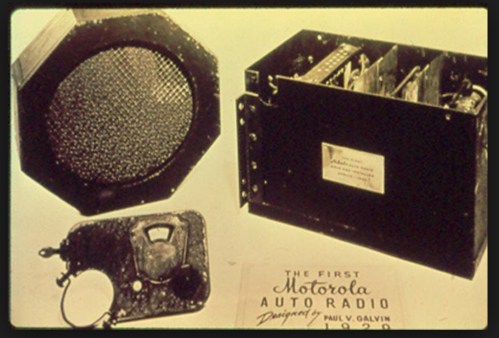
The “Motorola” Model 5T71, the first car radio
The idea for the car radio was born 90 years ago, by some accounts. The story of how that came about, and what the idea set in motion, is a fascinating one.
It would be a few years before the idea became feasible, but today of course the car radio is as ubiquitous as the automobile itself.
Commercial radio broadcasting began in the 1920s, and the whole industry was still in its infancy when William Lear (more on him later) and Elmer Wavering wondered if they could adapt a home radio to use in an automobile.
According to a story that Lear was fond of telling, the two young men were on a picnic with their lady friends, on a promontory overlooking the Mississippi River in Quincy, Illinois, one evening in 1929. One of the women said she wished they could listen to music, as they watched the sun set.
That started the whole idea. Both men had tinkered with radios, and had enough background in the basics that they thought it was possible. (Other inventors have claimed to develop the same notion a bit earlier or around the same time, but all automotive radios trace their genealogy from this ancestor.)
But there were issues: Besides having to downsize the whole radio apparatus, which was quite large in those early days of the technology, the men had to solve problems of durability – bouncing around in cars with primitive suspensions on early roads. And then were was static. This was an issue for all radios, and a number of companies began offering solutions to static in home-based radios. But a car presented a unique set of issues with interference from its electrical equipment, such as the generator, the spark plugs, and its ignition.
Lear and Wavering eventually presented their idea to Paul Galvin, who operated a small company in Chicago that specialized in making “battery eliminators” which converted home radios to run on household current; all radios up until about 1927 ran on separate, bulky storage batteries. Galvin was eager to expand into a new product category, and so he offered the men space in his factory to tinker with their radio.
They got a prototype up and running in a Studebaker, and decided to approach a banker for a loan, to go into business mass-producing car radio kits. To show how versatile the application could be for any car, the men installed a demonstration model in the banker’s Packard. But disaster happened: The system malfunctioned and set the car on fire. Needless to say, they didn’t get the loan.
Galvin refused to give up, however. He drove the Studebaker from Chicago to a radio convention in Atlantic City, New Jersey. When he arrived, he found he couldn’t afford to rent a booth at the show, so he ended up parking the car on the street outside the convention center, and blasting the radio to passersby. He managed to get enough people interested to start taking orders.
Galvin decided to call the radio “the Motorola“, a mash-up of the Victrola brand name and other popular radios of the time. The first model was designated the 5T71, for whatever reason.
The biggest problem for the young business was the cost of the unit: $110, uninstalled. That was a lot of money back then, during the depths of the Depression, when a new car cost $650 or so. Plus, it took two men several days to install the contraption and all its necessary parts, pieces and wires. The radio even needed its own source of power (i.e., a separate battery) in those early days. And it wasn’t exactly pretty, once installed.
It’s a miracle the company survived.
But the idea of putting a radio in a car was too popular to fail, it seems. Galvin said he lost money the first couple of years, until he perfected the system enough to get Ford Motor Company to begin offering them as options on its 1933 models. (Chrysler actually offered radios as options on a few 1932 models; General Motors wouldn’t join the radio craze until 1934.) Galvin got another big break – and a leg up on aggressive new rivals like Philco – when B.F. Goodrich agreed to begin selling simplified Motorola kits and installing them in existing vehicles, in their tire stores, for $55.
By 1934, a factory-installed radio could be had in a new car for $39.95 (an antenna cost extra!)
Motorola would go on to develop the first push-button radio in 1936; the company soon became an idea factory for innovations such as police cruiser radios, walkie-talkies, early home televisions and myriad other electronic marvels. Later, they even developed communications equipment for the first moon landing, pagers and early mobile phones. (Galvin’s company finally converted over to the Motorola name in 1947.)
And what happened to those enterprising young men, who originally turned the idea into reality? Wavering stayed on as an engineer with Galvin and Motorola. He was instrumental in developing the automotive alternator, which eliminated the generator; the alternator facilitated a whole new, more robust electronic architecture for the automobile, including such power-hogging amenities as air conditioning, power windows, power seats, and – yes – even better radios and stereo systems.
Lear leveraged his one-third ownership interest in the radio venture to strike out on his own as an inventor. In his lifetime, he would be issued more than 150 patents. He came up with tape players (remember four-track and eight-track?), helped develop radio direction finders for airplanes, played a key role in the development of aviation auto-pilot systems. And of course, his most famous invention: The Lear Jet, the world’s first mass-produced and (somewhat) affordable business jet.
Kind of makes you wonder how differently history might have been written without that sunset picnic?
Jerry Garrett
March 22, 2019
Leave a comment